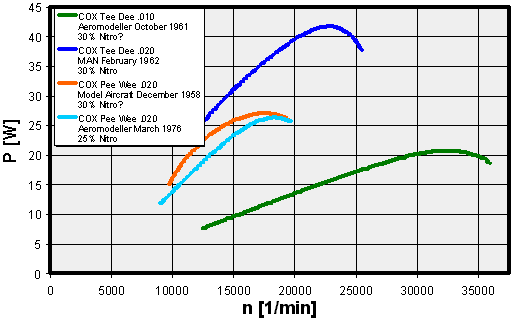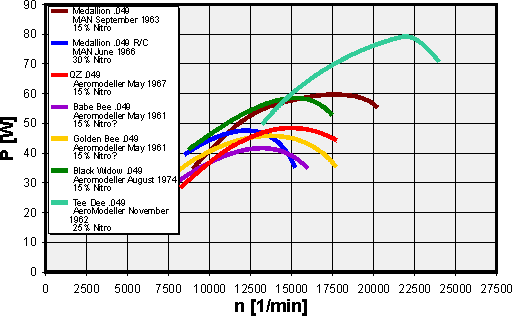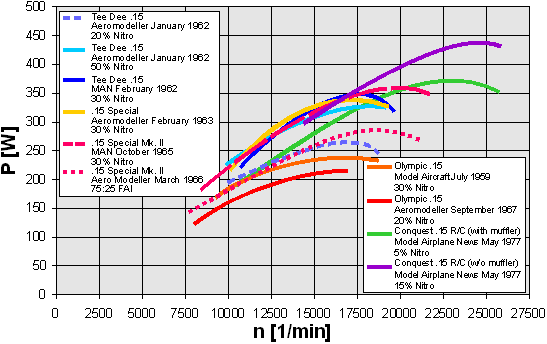|
|
| Recently people
have been asking for performance figures of Cox engines. This is because
these engines have been used in various small unmanned aerial vehicles (UAVs)
for academic and commercial applications. The power to mass ratio of these
small engines still makes them a very attractive choice for these
applications.
The curves below have been created by digitizing
graphs from old model magazines. I have never built a dynamometer small
enough for these engines. The power output has been converted to SI (metric)
units.
Special thanks go to Bob Gardner, Peter Tarn and Peter Grünbaum for digging
out the corresponding magazines. |
|
The smallest Engines (.010 ...
.020) |

The power output of the small Tee Dee .020 is really not
bad when compared to the larger and heavier engines. The tiny Tee Dee .010
produces excellent results at high speeds above 25'000 1/min. |
|
The small Engines (.049) |

The power output of all .049 reed valve engines seems to
be limited to speeds between 12'000 and 17'000 1/min. This is probably due
to blockage effects caused by the narrow flow paths around the reed
valve. The Tee-Dee .049 shows its clear performance boost over the
Medallion, albeit at higher speeds only. |
|
The medium sized Engines (.09) |

We note the clear power advantage of the Tee Dee over the
Medallion, but take into account that the nitro content of the fuel was
different. |
|
The large Engines (.15) |

The .15 Special Mark II shows the best performance figures for the
traditional Cox .15 engines. This is probably due to the new porting system
and different timing. Only the Conquest .15 with its radical new design
could be run at even higher speeds to outperform the Special. |
Last modification of this page:
21.05.18

[Back to Home
Page] Suggestions? Corrections? Remarks? e-mail:
Martin Hepperle.
Due to the increasing amount of SPAM mail, I have
to change this e-Mail address regularly. You will always find the latest version
in the footer of all my pages.
It might take some time until you receive an answer
and in some cases you may even receive no answer at all. I apologize for this, but
my spare time is limited. If you have not lost patience, you might want to send
me a copy of your e-mail after a month or so.
This is a privately owned, non-profit page of purely educational purpose.
Any statements may be incorrect and unsuitable for practical usage. I cannot take
any responsibility for actions you perform based on data, assumptions, calculations
etc. taken from this web page.
© 1996-2018 Martin Hepperle
You may use the data given in this document for your personal use. If you use this
document for a publication, you have to cite the source. A publication of a recompilation
of the given material is not allowed, if the resulting product is sold for more
than the production costs.
This document may accidentally refer to trade names and trademarks, which are owned by national or international companies, but which are unknown by me. Their rights are fully recognized and these companies are kindly asked to inform me if they do not wish their names to be used at all or to be used in a different way.
This document
is part of a frame set and can be found by navigating from the entry point at the
Web site http://www.MH-AeroTools.de/.
Impressum
Datenschutz



